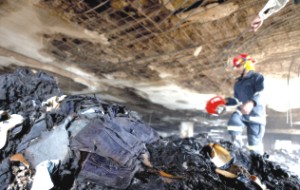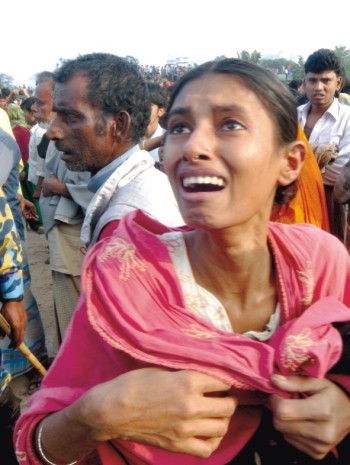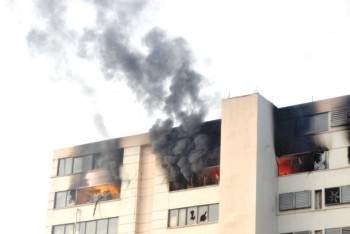Special Feature
Locked Doors and Lost Lives
Shudeepto Ariquzzaman
On December 14, 2010 a devastating fire broke out at approximately 1 pm in one of Bangladesh's leading garments factories owned by the Ha-meem Group. Official figures from the death toll stand at 26 dead and at least 100 injured. Fire at garments factories have posed a major threat to worker's safety over the years, though BGMEA states that in recent years, fire safety measures have improved. While that is probably true, the fact remains that at least 414 people have died between 2006 and 2009 in 213 factory fires, according to the Fire Service and Civil Defence Department. These figures do not account for the deaths from the recent incident at Ha-meem and the deadly fire at Gharib and Gharib earlier this year that killed at least 21 workers.
It was at lunchtime that the incident occurred in one of Ha-meem Group's factories called 'Thats it Sportswear'. As workers sat down for lunch at the canteen on the 11th floor, little did they realise that for many of them it would be their last meal.
“I had not yet started eating when suddenly I heard people shout 'fire', says Md. Shamim, a worker of the packing section. “Some of us went to the windows to figure out what happened. We supposed that there was some unrest in a nearby factory. Since these unrests have become normal for the last few days, we did not bother and returned to eat.” It was a fatal mistake, but considering the recent industrial unrests, it seems only natural.
 |
Piles of materials destroyed by the fire.
Photo: Rashed Sumon |
“Hardly had I started eating, I saw smoke coming out of Gate1 and 2. We were sitting in front of the middle stairs. All of us tried to rush out, but black smoke was already coming out from the stairs,” says Shamim. After that Shamim and some of his colleagues rushed to the sample section where there is an exit meant for the women workers. “We found the doors locked,” says Shamim. “There was also a corner gate at the backside, but to our horror, that gate was locked too.” What followed next was utter chaos and confusion. “There were people crying, shouting, it was a hopeless situation,” he says.
For Shamim and the others, there was still a slim chance of survival. “There was a grill in the south side,” he says. “I do not know how many of us were there, but it must have been 20 of us, trying to break the grill,” he says. Another survivor lying on the bed besides him in Gonoshastho Nagar hospital disputes him. “There were at least 50-60 of us who were pulling the grill with all our might,” he says. Whatever the figures, the men managed after considerable effort to break down the grill.
But the ordeal was hardly over. “Somebody found a rope, and that looked like the only way for escape. We started untying the knots of the ropes but time was running out quickly, and the whole floor was engulfed with black smoke and heat.” As the rope reached about 10 feet down, some of them decided to get down. “They were led by my supervisor Anis, who decided that he could make it with the rope,” says Shamim. However, according to Shamim's testimony, the rope was too short, and his supervisor made a mistake. “Five of them used the rope and all of them fell to the ground and died,” he says. “After he saw his uncle die, his nephew Rezaul became totally crazy. I tried to calm him down but all of a sudden he jumped out of the window.”
Another survivor Md. Shahed had more luck with ropes, considering that although he broke both his feet, he has managed to live. “I rushed to the gates, but already the black poisonous smoke was coming out. Four of the gates, as I remember were on fire. The two gates that were not on fire, were locked,” he says. Like Shamim, Shahed was also one of those who rushed to the south and joined the others in breaking the grill. “We found a jute rope, which could reach a good distance,” he says. It was then that Shahed took a very brave step. Noticing a helpless young girl who was his helper, he ordered her to climb down with him. According to the accounts given by survivors, this girl Ameena Begum was the only woman on the ill-fated top floors who had survived. “The rest of the women were killed,” claims Shamim.
 |
Accidents need to happen only once to destroy lives and families. Photo: Rashed Sumon |
“It takes a long time to untie the knots of this ropes,” says Shahed. “My original plan was upon reaching the 7th floor, I would use my legs and manage a grip on the window, from where we could reach the safety inside.” He had assumed quite correctly unlike many others, that the fire had originated at the top floors and the downstairs were safe, although he could not be sure of such a prospect at that time. “But when I reached the 7th floor, I looked upwards and saw that many others were also climbing down the rope. If I tried to get to the 7th floor, they could have fallen all over me and we would all die. I decided to get closer to the ground,” says Shahed. “I suppose I managed to get to the 3rd floor. After that, either the rope tore, or more likely I lost the grip. I fell to the ground. One of my legs broke, and in the other broken pieces of glass went in.”
As for Shamim, it was not the rope, but a more unconventional rescue material that came to his aid - - the long roll of denim fabric. According to Mahmud Ali, assistant administration officer, who witnessed five people jumping down from the top floors to death, it was these denim fabrics that had considerably helped lessen casualties. “Many of them slipped and fell to their deaths, but quite a few survivors were able to climb down using the material,” he says.
Climbing down using denim was not easy but for most of the survivors stuck on the top floors this presented the last chance. “The fabric is sharp and the fire had made it hot. It pierced through my hands,” says Shamim. “It was very painful and at one point I thought that I could not hold anymore,” he displays his bandaged hands and the bruised forearm caused by the fabric. “But I could not let go, the ground was still too far. When I had come closer, I jumped.” Fortunately he escaped with minor injuries. “Others had broken or twisted their legs by jumping like that,” says Shamim.
Amena Begum, the girl who had climbed down the rope with Shahed also lies injured in the hospital bed. “Most of the women could not get out of the fire. I have not seen any of the women, who were on the floor that day,” she says. “The rope which that man (Shahed) had used reached almost to the bottom,” she says. Ameena however states that her visions at the last moments on reaching safety of the ground are blurry. “As I reached near the ground, I fell down and cannot say what happened after that.”
Both her legs are broken. She also states that the exits were locked. “If the gates were open, many would have been saved.”
Similar sentiments are echoed by the survivors and other workers. “If the back doors of the cutting section and the canteen, or the women's exits at the sample section were open, this would not have happened,” says Shamim. “Also the management should have announced over microphone that only the 10th and 11th floors were on fire as most of us supposed that the downstairs were also on fire. This way many could have escaped.” Shameem and many other survivors lay the blame for this irresponsible behaivour on the security guards and the management.
But he does not blame the owners of the Ha-meem Group for this disaster. “The owner delegated the responsibility to the management, it is not possible for him to check out every factory. But the management is at fault,” he says. Other workers have stated that since their employers pay the salaries in time, allow facilities, and on the whole treat them well, there is little genuine grievance directed towards the ownership Ha-meem Group till date.
The management has repeated many times, that all the emergency gates were opened. However, numerous accounts by workers, eyewitnesses and survivors establish beyond doubt that many of the emergency gates were in fact locked.
Many factories lock doors to prevent their workers from slacking off or stealing materials. But as piles of clothes are easily combustible, locked gates place the lives of workers at risk, and accidents only need to happen once.
Officials of the factory have also confirmed that while there were in fact trained fire fighters in the factory, they too, had like the others gone to lunch. All the security guards of the factory currently on duty say that they did not have a shift that day.
 |
Accident or arson? Photo: Rashed Sumon |
BGMEA president Abdus Salam Murshedy says there was sufficient fire fighting equipment in the factory. “More lives could have been lost otherwise. Both the government and BMGEA are investigating the likely causes of fire,” he says and has requested the public to be patient. Murshedy has also requested the government to purchase more sky lifts that are capable of reaching up to the 11th floor. Currently, the fire brigade has four sky lifts, all of them in Dhaka. “In case of an emergency, it takes a long time to reach places like Gazipur,” he says. Murshedy also states that in the dry season, they have warned garments owners to be extra careful. As for the electric wires, he says that the fluctuation in electricity means that even if world-class electric cables are used, accidents remain a possibility. Short circuits have mostly been identified as the cause for previous fires at factories.
Two days after the incident, workers blocked the Dhaka-Tangail highway for two hours, demanding explanation on the whereabouts of, as they claimed, their missing colleagues. An eyewitness Sabina Yasmeen, who works on the site, says that she saw almost 30 people jump to their deaths. “The canteen room at lunchtime has 3000 workers,” she says. “I think the burnt corpses have been hidden. However, the management held a meeting with them and calmed them down.” These claims could not be verified. Yasmeen also says that workers in this particular factory are in good terms with their owners, and following promises from them have agreed to return to work and not agitate.
She also gives a chilling account of what she saw- “There was a burnt hand on the topmost floor, and it was waving. Then the hand burned out totally, and from them ashes fell down,” she says.
The cause of fire has not been determined as of filing this report. While the management of Ha-meem Group and BGMEA is cautious about stating the reason before a full scale investigation is conducted, many suspect that considering the current scenario of industrial unrest, arson is a strong possibility. It is mentionable that earlier, on June 29 2009, a group of agitating workers from other factories set fire on the premises of the Ha-meem Group.
For most of the injured survivors lying on the hospital bed, arson seems the only possibility. “I demand a proper investigation into the matter,” says Shahed. “Considering the nature of the fire, the way it spread so quickly, engulfing the 10th and 11th floor in about 5 minutes, most of us think that somebody had done this intentionally,” he says. Other injured workers have voiced the same suspicion. While the cause of the fire cannot be determined without a proper investigation, it is likely that even if other reasons are cited as the cause of fire, many workers will believe otherwise.
Meanwhile in the industrial areas of Gazipur and other places where garments factories are situated, industrial unrest has flared up in preceding days, and the incident at Ha-meem risks adding 'fuel to fire'. As a tired police officer on duty at the site complains, “why did this have to happen now when a andolon (movement) is going on? The incident risks inciting violence among the already agitated workers and makes things worse for us.”
Copyright
(R) thedailystar.net 2010 |
| |
